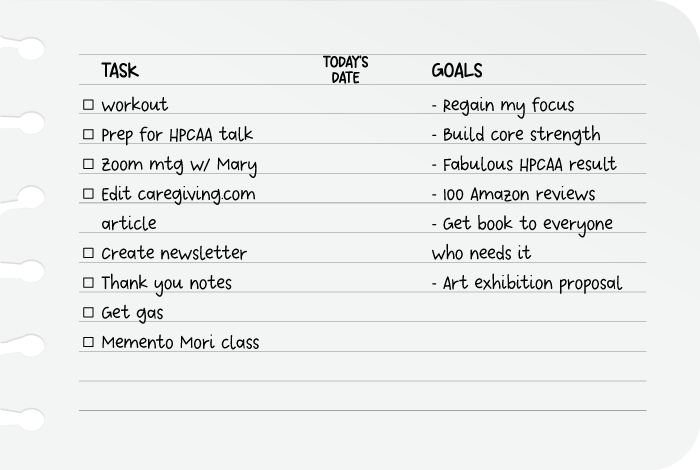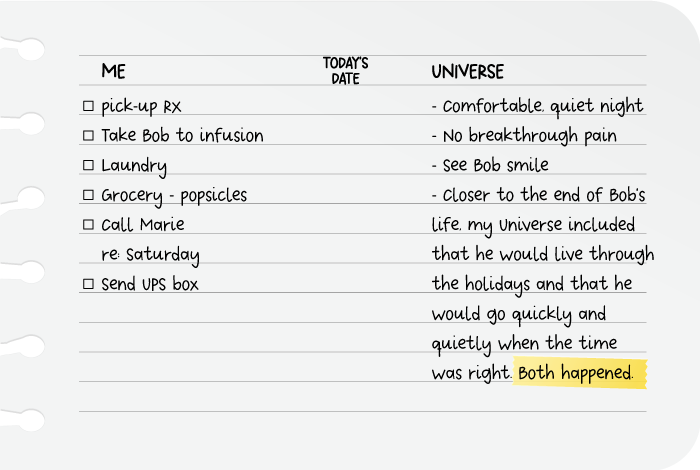In a recent conversation with Robert Pardi, the widower of a palliative care and hospice physician, we discussed how much more effective our organizational skills were back when we were family caregivers, compared to how they are now as authors. We agreed we were so much better at organizing tasks then because the stakes were so much higher, as family caregiving is the paramount job most of us will ever be called to do. Robert and I agreed: deadlines, presentations, courses and book sales are important tasks to accomplish as authors, but they simply do not hold the gravitas family caregiving does.
The to-do list method I developed while caring for my late husband continues to serve me well, so I thought I would share these tips for optimizing your caregiving task list.
Here are my top five tips for more effective to-lists:
1. Use the modality that works for YOU.
The best technology is only effective if it’s used consistently. A pocket notebook is more effective than an app for me. I carry a notebook about the same size as my phone. Duplicative? Nope, because I use the notebook all day, every day, and it consistently helps me get my tasks completed and overall goals met. If you have an app that works for you, use it. If you prefer a larger notebook, use that.
2. Include both tasks and goals.
That’s right, I want to do it all — complete tasks and achieve overall goals and aspirations. How can I do both at once? My daily “Task/Me” list includes individual items I need to get done in a timely manner. My “Goals/Universe” list includes larger projects unlikely to get done today or tomorrow that I need to keep in mind. This list includes upcoming deadlines and big stuff that may require more help or attention. Each page of my mini notebook says “Me” at the top left, with today’s date in the middle and “Universe” at the top right. If you prefer the terms “Tasks” and “Goals” or your own language, use that.
3. Apply ambitious realism.
Be determined with your daily list, but do not include more tasks than you can realistically do in a typical, productive day. Overly zealous lists will only generate a sense of defeat before you even get started.
Don’t list tasks you automatically do, like shower or workout, unless you are having a particularly difficult time getting them done. As an example, I fell out of my gym-based, workout habit during the pandemic and have had a tough time resuming after vaccination, so I started putting it on my daily Tasks/Me list. That way, the word faces me each time reference the list holding me accountable. Hopefully, soon the workouts will become a habit again and won’t need to be listed.
4. When you finish a task, cross it off.
This is important for two reasons. First, to pause and celebrate the accomplishment. Yay you! Second, to see what remains undone and select the next task to cross off your list. I like to put just one or two thin lines through the task, rather than using the redaction method so I can see the task and when I accomplished it if I need to look back at some point. You can also draw a little, blank box next to each item and color it in upon completion. As mentioned, do what works best for YOU.
5. Tell the Universe what you want to see happen.
The list on the right for “Goals/Universe” represents:
- Larger projects to keep in mind.
- Upcoming deadlines.
- Big stuff that may require help from a force larger than ourselves.
Those first two points are helpful to not forget larger, upcoming tasks and looming deadlines The third point refers to the “big stuff,” which is something I learned while caregiving. I started to tell the Universe the positive action, effect, or result I wanted rather than worrying about the worst happening. For several years now, I have been replacing my worries with positive directives for the Universe, and it has helped me tremendously.
Below are two daily lists. The first is from a day in my life now. The second is from a day in my life when I was my beloved Bob’s caregiver.


From these two samples you can see what Robert Pardi and I were talking about. The work we are doing now is important. Still, the importance pales in comparison to when we were caregiving and the work you are doing now.
Author’s note: I am the above mentioned hospice doctor’s widow as my husband Bob was a palliative care and hospice doctor who died of cancer. Robert Pardi’s late wife, Desiree, also died of cancer amid a successful career as a palliative care and hospice physician in New York.
